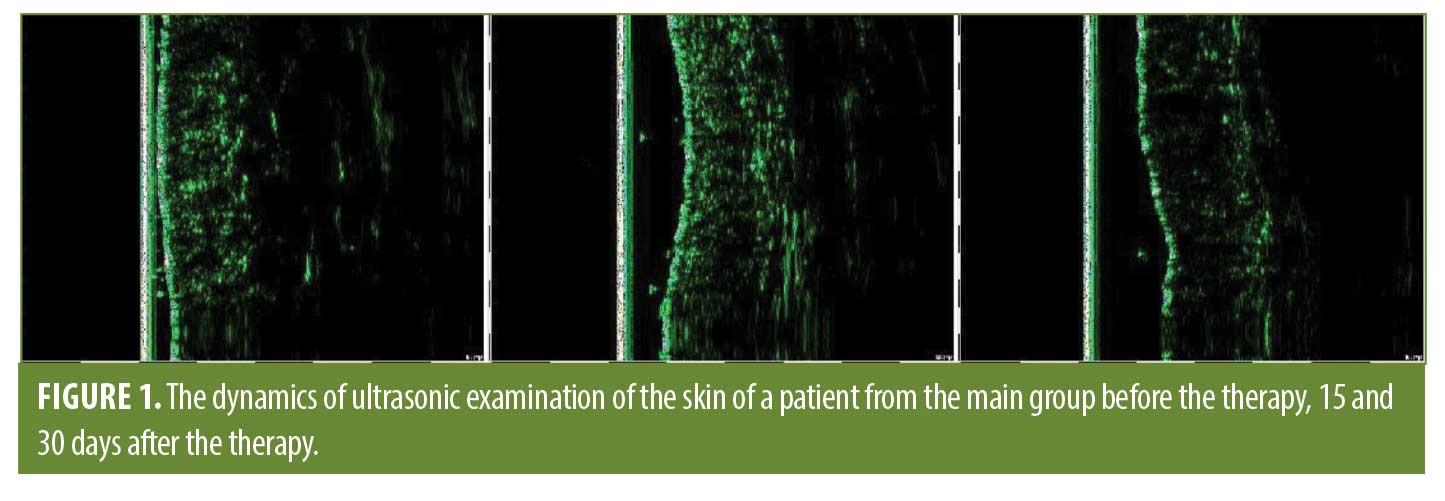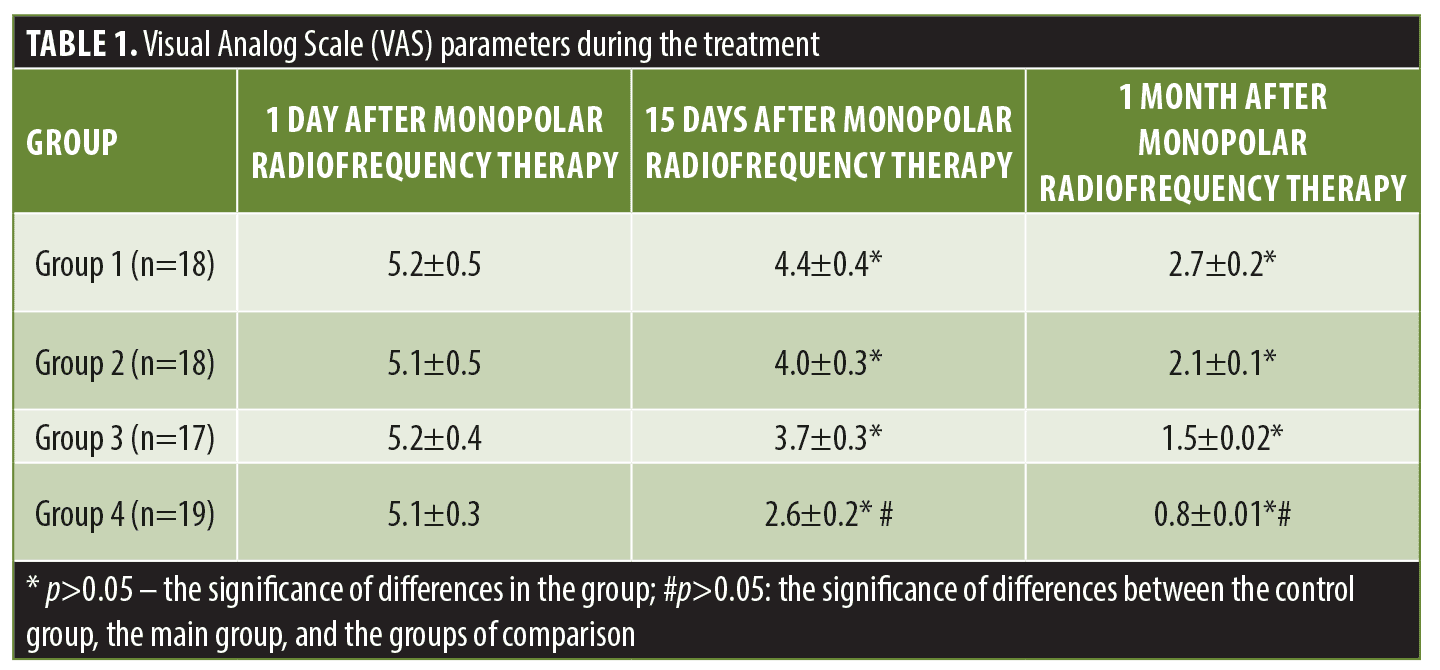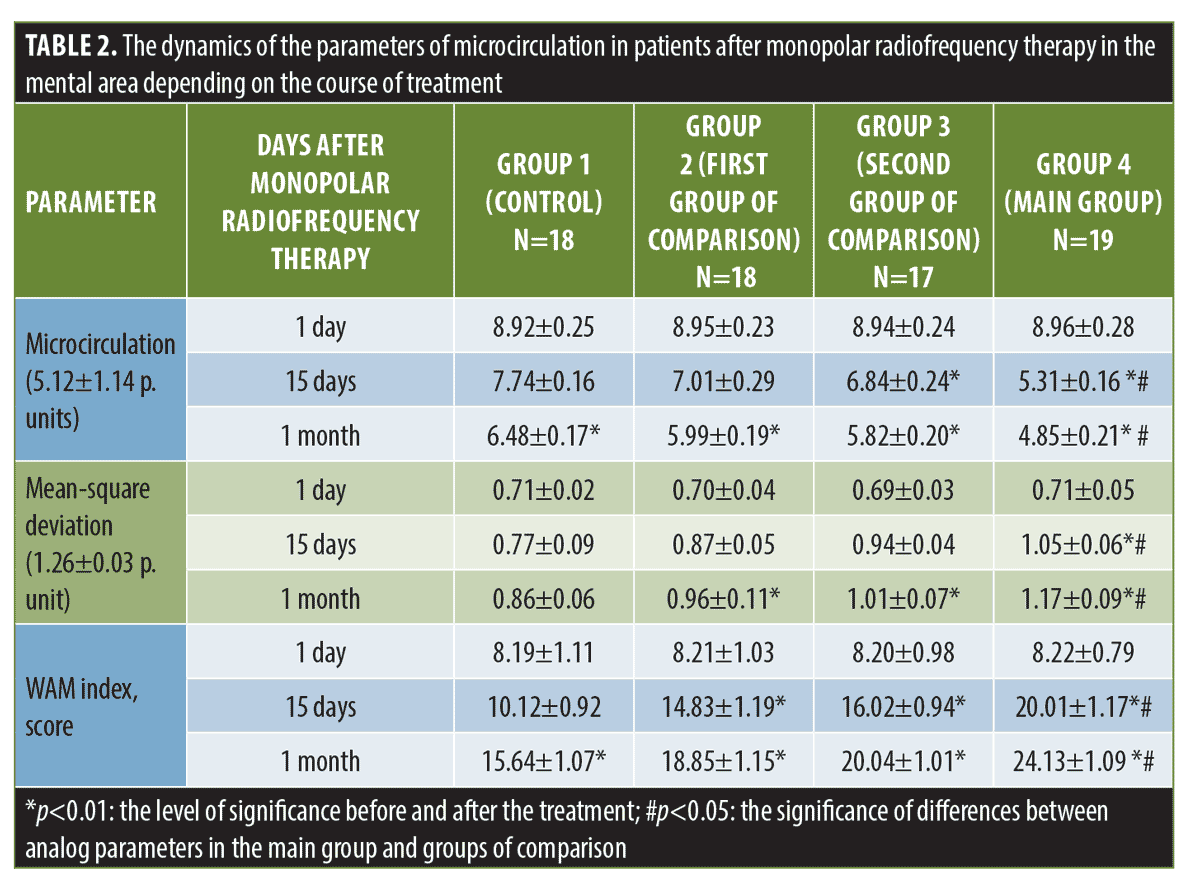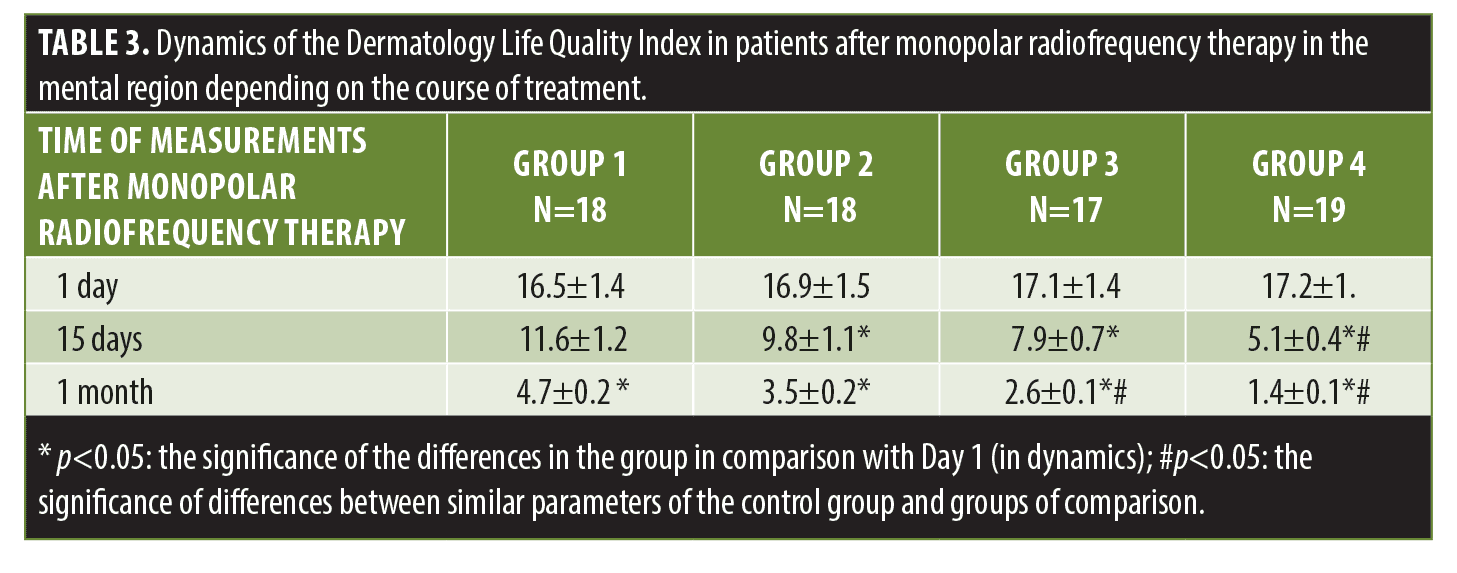 J Clin Aesthet Dermatol. 2022;15(3):44–47.
J Clin Aesthet Dermatol. 2022;15(3):44–47.
by Irina Aksenenko, PhD; Marina Gerasimenko, MD and Arkadiy Aksenenko, PhD
Dr. Irina Aksenenko and Gerasimenko are with the Federal State Budgetary Educational Institution of Further Professional Education “Russian Medical Academy of Continuous Professional Education” of the Ministry of Healthcare of the Russian Federation in Moscow, Russia. Dr. Arkadiy Aksenenko is with State Research Center, Burnasyan Federal Medical Biophysical Center FMBA of Russia in Moscow, Russia.
FUNDING: No funding was provided for this article
DISCLOSURES: The authors report no conflicts of interest relevant to the content of this article.
ABSTRACT: Background. In aesthetic medicine, high-power instrumental technologies that exert a significant positive effect with a minimal rehabilitation period are becoming more popular in the correction of involutive changes of the skin. Such methods include monopolar radiofrequency therapy. However, high temperature can lead to the development of unfavorable events and complications.
Objective. The study aimed to design and evaluate a combined method of monopolar radiofrequency therapy and injective carboxytherapy in patients with local adverse events (edema and neuropathy) in the facial area.
Methods. The study included 72 female patients aged 38 to 52 years old that earlier received monopolar radiofrequency therapy in the facial region for the correction of involutive changes in the skin and who developed edema and neuropathy in the area of radiofrequency impact. Four groups received injectable carboxytherapy locally, in the projection of lymph nodes, or in combination.
Results. Combined application of monopolar radiofrequency therapy in the facial region and an extended protocol of carboxytherapy as local application or application in the projection of regional lymph nodes exerts a significant positive effect in the short-term and long-term study period reducing the period of rehabilitation. This was demonstrated by a statistically significant reduction of the intradermal edema and quick regression of pain syndrome in the studied group with the extended protocol of carboxytherapy in comparison with other studied groups.
Conclusion. It is feasible to apply an extended protocol of carboxytherapy (locally, in the area of expressed manifestation, and in the projection of regional lymph nodes) in patients with local edema and neuropathy that developed after received monopolar radiofrequency therapy in the facial region, which significantly reduces the rehabilitation period and contributes to faster reduction of local edema and neuropathy and provides a stable clinical result.
Keywords. carboxytherapy, neuropathy, calcium hydroxyapatite, complication, filler
Presently, in aesthetic medicine, high-power instrumental technologies that exert a significant positive effect with a minimal rehabilitation period are becoming more popular in the correction of involutive changes of the skin.1 Such methods include monopolar radiofrequency therapy that is based on deep and vast heating of tissues. A generator of high power alternating current (frequency 6.78 MHz) generates an alternating electromagnetic field of a certain configuration, which changes polarity seven million times per minute to generate heat due to tissue resistance.2,3 The procedure is performed one time. Its effect lasts for 3 to 5 years. However, there are some difficulties in the prognosis of skin response to high-power instrumental methods that include monopolar radiofrequency therapy. The clinical effectiveness of this method depends on the electroconductivity of the skin, which in turn, depends on numerous internal and external factors, for example, a morphotype of involutive changes, age, etc. Preliminary ultrasound examination of the skin can be helpful in the prognosis of clinical effects. Its results indirectly provide the data on the structure of the derma and epidermis, its density and thickness, earlier injections of fillers and threads. For example, when affecting dry skin with thinned derma, the risk of thermal damage of important anatomic structures, including nerve stems, with further edema and neuropathy significantly increases. Preliminary ultrasonic diagnostics can minimize possible complications and decrease the risks of their development.4
There are some known cases of the ineffectiveness of this method and patients that were not satisfied with the results of monopolar radiofrequency therapy, which is considered by patients as adverse events. Due to the impact of high temperature, there were some reported cases of persisting edemas, neuropathies, and burns of different degrees. According to different statistical data, the duration of the rehabilitation period was around 17 days. Patients complain of paresthesia, anesthesia, hypoesthesia, or hyperesthesia, provoked by nervous tissue ischemia caused by edema and skin inflammation in the region of local application of high temperatures (diathermy). When this method is used in the facial (area, the above-mentioned symptoms primarily occur in the submental area. There are numerous pharmacological and physiotherapeutic methods of correction of local edema and neuropathies, for example, magnetotherapy, medicine electrophoresis, local darsonvalization, ultrasonic therapy, etc.5-8 All described methods target the improvement of microcirculation and reduction of the local edema in the affected area. One of the methods that improve the condition of microvasculature, drainage, and trophic of tissues is injectable carboxytherapy (mesotherapeutic injection of carbon dioxide (CO2)).9,10 It was demonstrated that injectable carboxytherapy accelerated processes in tissues, enhanced neocollagenesis, improved skin tonus, and smoothened age-related skin alterations.9, 11
Thus, the search for and study of new and more effective methods for restoration and rehabilitation of patients with local edema and neuropathy are acute in the area of treatment of adverse events in cosmetology. They include the early start of rehabilitative measures and a grounded choice of methods of recreation. The study aimed to design and evaluate a combined method of monopolar radiofrequency therapy and injective carboxytherapy in patients with local adverse events (edema and neuropathy) in the facial area.
Methods
This study included 72 female patients aged 38 to 52 years old. All patients underwent monopolar radiofrequency therapy with ThermaCool CPT (Solta Medical Inc., Bothell, Washington) in the facial area with a Face Tip at the rate of 1200 pulses according to the approved protocol for the correction of involutive changes of the skin. The apparatus and the method are registered in the Russian Federation (registration certificate No. FSZ 2010/06805 dated May 24, 2010, has no expiration date).
All patients were treated and followed up at the Clinics of Aesthetic Medicine from 2017 to 2020. Patients were randomized into four groups. Group 1 (control, n=18) only conventional local topical antiedematous pharmacotherapy (Lioton gel, BID, up to 1 month). Group 2 (first group of comparison, n=18) received conventional therapy in combination with local subcutaneous injective carboxytherapy in the mental area.Group 3 (second group of comparison, n=17) received conventional therapy in combination with injective carboxytherapy was performed only in the projection of regional lymph nodes, including submandibular, neck, and supraclavicular ones. Group 4 (main group, n=19) received conventional topical therapy in combination with injective carboxytherapy was performed not only locally in the mental area but also in the projections of regional lymph nodes including submandibular, neck, and supraclavicular ones.
Carboxytherapy was performed a day or two after the development of expressed edema and local neuropathic events.
The following tests were conducted for the objective evaluation of patients’ condition and their dynamics during the rehabilitation after monopolar radiofrequency therapy:
- Ultrasonic sonography for the evaluation of echostructural peculiarities of epidermis and derma and a degree of edema in the mental area with Dub Cutis 22-75 (TPM, Germany) and a 30-MHz sensor (registration certificate No. RZN 2016/5165 of April 26, 2017, has no expiration date). The thickness of derma and the coefficient of derma density was evaluated, which indirectly indicated the level of dermal edema.
- The evaluation of a degree of pain syndrome by the Visual Analog Scale (VAS)
- The evaluation of the general condition of patients by the scale of Dermatology Life Quality Index (DLQI), where the given parameter was measured within the range from 0 to 30.
- Clinical and biochemical blood assay
Condition of capillary circulation in the mental skin area was checked by the method of laser doppler flowmetry using a LAKK-01 apparatus. Such parameters as microcirculation, its mean square deviation, and the coefficient of variance were automatically calculated. The tonus of microvasculature was evaluated using amplitude-frequency analysis of the fluctuations in the bloodstream.
Patients were examined before carboxytherapy therapy, 15 days, and one month after the therapy. Injective carboxytherapy was performed with a CarboxyPen apparatus (France), which is a diffusion injector for injection of different substances (including CO2) in tissues. CarboxyPen is connected with a special feeding tube for CO2. The method of subcutaneous injection of CO2 is mesotherapeutic with thin needles (32G – 4mm). One injection contained from 1 to 3 ml of CO2, a course consisted of 5 procedures performed every other day. Patients from the first group of comparison received 5mL of gas only in the mental area. Patients from the second group of comparison received 8–10 ml of CO2 only in the projection of regional lymph nodes, including submandibular, neck, and supraclavicular ones. Patients from the main group received around 12–15 mL of CO2 locally in the mental area and in the projection of regional lymph nodes (submandibular, neck, and supraclavicular area).
All statistical calculations were performed in a software package Statistica for Windows 10 (StatSoft Inc). For the analysis of the obtained data, the authors used methods of descriptive statistics (number of patients, mean values, confidential interval, minimum and maximum values, standard deviation, standard error). For the comparison of groups of patients, methods of non-parametric statistics were used, in particular, the Mann-Whitney U-test (non-parametric alternative to a t-test for independent samplings).
Results
A day or two after the received monopolar radiofrequency therapy at the rate of 1200 pulses according to the protocol, patients complained not only of local hypo-, hyper-, para-, or anesthesia when touching the face but also expressed local edema in the area of application (primarily in the submandibular area).
During the examination, special attention was paid to the condition of the skin, its turgor, and local temperature-related anomalies in the dynamics. During the injection of CO2, all patients had short-term hyperemia (not more than 5 minutes) in the area of gas injection. All the patients showed positive dynamics after a course of carboxytherapy. Edema and swelling resolved in the facial area, especially in the mental region. The most evident dynamics of the degree of local skin edema in the mental area was detected by the ultrasonic apparatus DUB on Day 1, 15, and 30 after monopolar radiofrequency therapy in the facial area. According to the results of ultrasonic examination with a 30-MHz sensor, intradermal edema and a decrease in the dermal thickness in the mental area of patients from the main group on Day 15 after focused highly-intensive ultrasonic exposure reduced only by 21±2%; in the first group of comparison, by 37±3%; in the second group of comparison, 41±4%; and in the main group, by 53±5%. After one month, in the first group, it reduced by 57±5%; in the second group, by 69±5%; in the third group, by 76±6%; and in the fourth group, 92±8%. In the case of one patient from the main group, expressed positive dynamics in the reduction of intradermal edema on Day 15 and 30 were observed in comparison with the baseline scanning of the skin on the following day after monopolar radiofrequency therapy with ThermaCool CPT (Solta Medical Inc., Bothell, Washington) in the facial area with a Face Tip at the rate of 1200 pulses according to the approved protocol for the correction of involutive changes of the skin (Figure 1).

Pain syndrome was characterized by para-, hypo-, or hyperesthesia in the skin of the mental area. It was noted that in patients from the main group, the above-mentioned symptoms decreased more evidently than in the first and second groups of comparison, and in the control group. In all the groups, the clinical effect was expressed not only in a decrease of pain sensations in the facial area but also in the improvement of general wellbeing, mood, and normalization of sleep (Table 1).

In all the groups, the study of capillary bloodstream using laser Doppler flowmetry showed that on Day 1 after monopolar radiofrequency therapy, a decrease in the parameters that characterized the variability of their microhaemodynamics was observed. In the main group (unlike the rest groups), expressed positive dynamics of the parameters of laser Doppler flowmetry were observed. The results of the study showed that in patients, who received carboxytherapy not only locally in the area of neuropathy and edema but also in the projection of regional lymphatic nodes along the pathways of lymph outflow, including submandibular areas, microcirculation started to normalize right after the end of the course of carboxytherapy. Besides, in the main group, impaired basal circulation significantly improved in the skin of the mental area. At the same time, the coefficient of variance significantly improved, which could indicate the restoration of the regulation of tissue circulation in the area of application of monopolar radiofrequency therapy in the facial area along with the changes in microcirculation. On the other hand, in the control group, there was an insignificant change in the parameters of laser Doppler flowmetry, which could indicate an insufficient influence of the conventional topical therapy on microcirculation. In the groups of comparison in comparison with the main group, the changes were significantly less expressed. In the second group of comparison, positive dynamics of the studied parameters of microcirculation were more significant, which indicates a direct correlation between edema reduction due to an acceleration in the lymph outflow and symptoms of neuropathy (Table 2).

All patients were made general clinical and biochemical blood assays. There were no significant changes in the dynamics.
The inclusion of injective carboxytherapy after monopolar radiofrequency therapy in the facial area exerted a positive effect on DLQI. This confirms the data obtained by other studies and indicates a significant decrease in the rehabilitation period on Day 15 after monopolar radiofrequency therapy (DLQI in the main group was 2.27 times lower than in the first group, 1.92 times lower than in the second group, and 1.55 times lower than in the third group) and a month after monopolar radiofrequency therapy in the facial area (DLQI in the main group was 3.36 times lower than in the control group, and 2.5 and 1.86 times lower than in the second and third groups, respectively). This indicates significant positive results of a combined application of the extended protocol of carboxytherapy and monopolar radiofrequency therapy in the facial area in the short-term and long-term studied period (Table 3).

Conclusion
The present study showed that in patients with local edema and local neuropathy caused by monopolar radiofrequency therapy at the rate of 1200 pulses according to the protocol, the indication of carboxytherapy was feasible not only locally in the submental area and area of expressed edema and neuropathy but also along the pathway of lymph outflow and in the projection of regional lymph nodes, which significantly reduces the period of rehabilitation, contributes to a faster resolution of edema and neuropathy, and provides a stable clinical result. It is especially recommended for patients of the senior age group and patients with thin skin. The indication of this method for the application only in the third lower part of the face and mental area significantly prolongs the period of rehabilitation because of local neuropathy and expressed edema, which worsens the quality of life of patients and brings discomfort. This issue is resolved by an extended protocol of injective carboxytherapy not only in the region of adverse events after monopolar radiofrequency therapy at the rate of 1200 pulses according to the extended protocol but also in the projection of regional lymph nodes (including submandibular, neck, and supraclavicular area), which improves microcirculation, activates the venous and lymphatic part of microcirculation, increases the rate of oxygen extraction by tissues, and enhances metabolism. More active lymph outflow to the regional lymph nodes is observed. Due to this method, it is possible to perform these procedures already in the early rehabilitation period (from the first day after monopolar radiofrequency therapy at the rate of 1200 pulses according to the extended protocol), which not only softens and reduces the time of post-procedural rehabilitation but also prevents the development of such serious complications as burns, post-traumatic hyperpigmentation, and cicatrix processes.
References
- Nerobeev AI, Malakhovskaya VI, Alikova AV. Possibilities of application of minimally invasive radio frequent lifting in the correction of involutive changes in soft tissues of the face and neck. Issues of Aesthetic Medicine. 2013;1:44–50.
- Abraham MT, Ross EV. Current concepts in nonablative radiofrequency rejuvenation of the lower face and neck. Facial Plast Surg. 2005;21:65–73.
- Finzi E, Spangler A. Multipass vector (mpave) technique with nonablative radiofrequency to treat facial and neck laxity. Dermatol Surg. 2005;31:916–22.
- Aksenenko IP, Gerasimenko MY. The evaluation of the criteria of ultrasound diagnostics of the skin as a prognostic factor of adverse events after monopolar radiofrequency therapy. Physiotherapy, Balneology, and Rehabilitation. 2019;18(3):140–144.
- Nuvakhova MB. Polyneuropathy: methods of treatment and rehabilitation. Medical Sciences. 2019;17.
- Marchenko LA, Badalov NG, Gerasimenko MY, Martynova EV. Modern possibilities and perspectives of physiotherapeutic and balneologic methods of treatment and rehabilitation of patients with diabetic neuropathy. Physiotherapy, Balneology, and Rehabilitation. 2016;15(6):322–27.
- Lazarenko NN, Gerasimenko MY, Khamidullin GH. Multichannel electrostimulation and nivalin-electrophoresis in the rehabilitation of patients after plastic surgery in the facial region. Issues of Balneology, Physiotherapy, and Rehabilitative Physical Therapy. 2011;5:39–44.
- Kruglova KS, Korchazhkina NB, Turbovskaya SN. Physiotherapy in dermatology. Moscow; 2016. p. 31–40.
- Butatyan ND, Drozgovoz SM, Kononenko AV, Prokofiev AB. Carboxytherapy is one of the innovative directions in balneology. Issues of Balneology, Physiotherapy, and Rehabilitative Physical Therapy. 2018; 95(5):72–6.
- Aksenenko IP. Software for selection and performance of injective carboxytherapy as a method of correction of adverse events in cosmetology. Certificate of state registration of computer software No. RU 2018660371; 2018.
- Brandi C. Carboxytherapy. Practical manual with clinical indications and protocols. 2019; 142.

